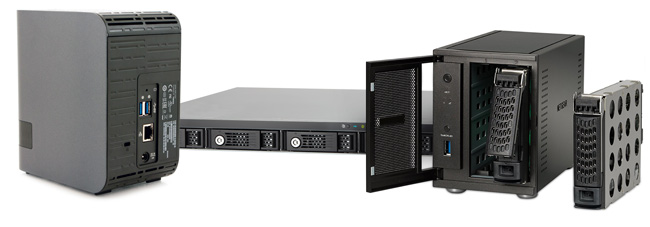Network Attached Storage (NAS) devices are becoming more and more popular not only in enterprises, but also in medium-sized and smaller companies. Compared to servers on Intel platform, they are inexpensive, consume less electricity, and are easier to maintain even for a less experienced person. DERA BOR Data Recovery has proven experience in recovering data not only from enterprise class storage systems such as DELL-EMC, HP, IBM but also from popular smaller appliances like those from Synology, Drobo, QNAP, Buffalo, Netgear, WD and others.
Most NAS devices use various types of “smart” RAIDs for fault tolerance and data storage. Many manufacturers of NAS devices offer their own RAID management systems, which allow users to combine hard drives from different brands into rather complex RAID systems, without much knowledge of the RAID technology itself. This creates additional difficulties in data recovery, as it requires an individual approach to arrays of drives from different manufacturers.
A majority of the commercial NAS devices run on customized versions of Linux and differ from regular computers because they do not have video outputs, and it is impossible to connect a keyboard and mouse to them. Therefore, that makes it impossible for data recovery programs to use direct access to disk space. That’s why DERA BOR Data Recovery creates disk images, as professionals always do, using ZCOPY technology, and performs all data recovery operations from said images.
In its simplest form, the NAS consists of one or two hard drives and a network controller controlled by a Linux-based operating system. More complex devices consist of a file server with a disk array of 24 or more disks combined into RAID arrays (RAID 0, RAID 10, RAID 5, RAID 6 or ZRAID). The most commonly used file systems are Ext4, BTRFS, XFS, and ZFS.
In case of large capacity disks (often dozens of terabytes), any classical partition table handled by LVM won’t work. To ensure safety, DERA BOR Data Recovery needs to evaluate the status of each drive in order to select the best methods for creating sector-by-sector copies. Making full copies is a compulsory step, although sometimes it doesn’t seem as important and is considered by some to be a process that only delays the data recovery procedure.

For partitions consisting of one segment, the procedure for assembling arrays will not be any different from finding partitions on a regular RAID array. In the case of volumes with a lost (and often rewritten!) LVM partitions tables, which consists of 2 or more fragments, additional steps will be required:
Speaking of the shortcomings of NAS-storage, we can easily make a list of which problems tend to be the most significant:
Many of the NAS servers are equipped with recovery functionality, but it is applicable only to restoring various hardware and software components of the device itself. It can’t be used to restore user files. Therefore, a professional approach and professional tools are required here, which by definition, cannot be utilized by the ordinary user.
Network-attached storage (NAS) is a file-level (as opposed to block-level storage) computer data storage server connected to a computer network providing data access to a heterogeneous group of clients. NAS are accessible over a network using an Ethernet connection and file protocols like SMB/CIFS (Server Message Block/Common Internet File System) or NFS (Network File System).
NAS is popular way of creating network file shares within an organization, where authorized personnel often collaborate on the same files or other forms of business information. It can also be used to keep a backup of files in case a local drive gives out and consolidate multimedia libraries, among other use cases where storing and trading files over a local network comes in handy.
Typically, the more high-end the NAS system, the more RAID configuration options are available. High end systems for larger organizations from the likes of Dell EMC, HPE, and NetApp offer a plethora of RAID options that storage administrators can use to meet their file storage capacity, performance and data protection requirements. NAS appliances can utilize RAID technologies, they work well together or completely apart in many cases. Home and enterprise users can create a RAID configurations unless they choose a JBOD (just a bunch of disks) mode.
Performance wise, components that was used to build NAS will define overall performance:
In a RAID configuration, performance characteristics are governed by the quality and type of hard drives used, type of RAID controller and the RAID level selected. A RAID-6 implementation will deliver good read speed while write speeds suffer somewhat because the RAID array needs to store and manage parity information to provide fault tolerance, for example.




